- Products
- Product Lines
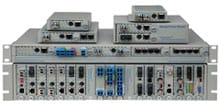
- iConverter Managed Multi-service Platform
- Copper to Fiber Media Converters
- Ethernet Media Converters
- 10 Gigabit Copper-to-Fiber
- 10/100/1000 Copper to 10 Gigabit Fiber
- 10/100/1000 Copper-to-Fiber with Integrated Management
- 10/100/1000 Industrial Copper-to-Fiber with Integrated Management
- 10/100/1000 Copper-to-Fiber with VLAN
- 10/100/1000 Dual Media Converter with VLAN
- Gigabit Copper-to-Fiber
- 10/100 Copper-to-Fiber with Integrated Management
- 10/100 Industrial Copper-to-Fiber with Integrated Management
- 10/100 Copper-to-Fiber with VLAN
- 10/100 Copper-to-Fiber
- Fast Ethernet Copper-to-Fiber
- Fast Ethernet Redundant Links
- 10Mbps Copper-to-Fiber
- 10Mbps Copper to Coax
- TDM Media Converters
- Serial Media Converters
- Ethernet Media Converters
- Fiber to Fiber Media Converters
- 10 Gigabit Fiber-to-Fiber Converter and Transponder
- 10 Gigabit Industrial Converter and Transponder
- SFP-to-SFP Fiber Converter and Transponder
- SFP-to-SFP Industrial Fiber Converter and Transponder
- Gigabit Fiber to-Fiber with 3 Rs
- 100/1000 Fiber-to-Fiber with 3 Rs
- Gigabit Fiber-to-Fiber
- Fast Ethernet Fiber-to-Fiber with 3 Rs
- Fast Ethernet Fiber-to-Fiber
- OC-3/STM-1 Fiber-to-Fiber
- OC-12/STM-4 Fiber-to-Fiber
- Carrier Ethernet Network Interface Devices
- CE 2.0 - 10G Demarcation NID
- CE 2.0 - 10G Demarcation and Aggregation NID
- CE 2.0 - 10/100/1000 Mult-port NID
- CE 2.0 - 10/100/1000 Mult-port NID with PoE
- CE 2.0 - 10/100/1000 8-Port NID
- SFP NID - Gigabit SFP NID
- microNID - 100/1000 compact NID
- CE 1.0 Service OAM - 10/100/1000 NID
- CE 1.0 Link OAM - 10/100/1000 Copper-to-Fiber NID
- CE 1.0 Link OAM - 10/100 Copper-to-Fiber NID
- CE 1.0 Link OAM - Gigabit Fiber-to-Fiber NID
- CE 1.0 Link OAM - Fast Ethernet Fiber-to-Fiber NID
- CWDM Multiplexers
- T1/E1 Multiplexers
- Ethernet Switch Modules
- Management System
- Chassis Options

- 1-Module Industrial Chassis

- RuggedNet Industrial Switches and Extenders
- Industrial PoE PSE Fiber Switches
- Multi-Gigabit Managed Industrial PoE+/BT Switches
- Multi-Gigabit Unmanaged Industrial PoE+/BT Switches
- 10G Managed 802.3bt PoE Switches
- 10G Unmanaged 802.3bt PoE Switches
- 10G Managed PoE+ Switches
- 10G Unmanaged PoE+ Switches
- 1G Managed PoE+ Switches
- 1G Unmanaged PoE+ Switches
- 1G Unmanaged 802.3bt PoE Switches
- 1G Managed 802.3bt PoE Switches
- Industrial Ethernet Switches
- Industrial PoE Copper Extenders
- Industrial Power Supplies

- OmniConverter Media Converter, Switches and Extenders
- PoE PSE Media Converters
- 10/100/1000 Multi-port PoE Media Converter
- 10/100/1000 Multi-port High-Power PoE Media Converter
- 10G Multi-Gigabit / Multi-Rate PoE Media Converter
- 10G Multi-Gigabit / Multi-Rate Media Converter
- Industrial 10/100/1000 Multi-port PoE Media Converter
- 10/100/1000 Cost-Effective Multi-port PoE Media Converter
- 10/100 Multi-port PoE Media Converter
- Industrial 10/100 Multi-port PoE Media Converter
- 1U Rack-Mount Shelf
- 10/100 Cost-Effective Multi-port PoE Media Converter
- PoE PSE Compact Switches
- Multi-Gigabit Managed PoE+/BT Switches
- Multi-Gigabit Unmanaged PoE+/BT Switches
- 10G Managed 802.3bt PoE Switches
- 10G Unmanaged 802.3bt PoE Switches
- 10G Managed PoE+ Switches
- 10G Unmanaged PoE+ Switches
- 1G Managed PoE+ Switches
- 1G Unmanaged PoE+ Switches
- 1G Managed 802.3bt PoE Switches
- 1G Unmanaged 802.3bt PoE Switches
- Ethernet Switches
- PoE Copper Extenders
- PoE Injectors
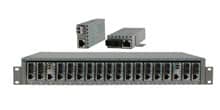
- miConverter Unmanaged Miniature Media Converters
- 10/100/1000 Copper-to-Fiber
- Industrial 10/100/1000 Copper-to-Fiber
- 10/100/1000 Ultra-Compact Copper-to-Fiber
- Gigabit Copper-to-Fiber
- 10/100/1000 Copper-to-Fiber PoE Powered
- 10/100 Copper-to-Fiber
- 10/100 Ultra-Compact Copper-to-Fiber
- 10/100 Copper-to-Fiber PoE Powered
- 18-Module Chassis
- Industrial 10/100 Copper-to-Fiber PoE Powered

- FlexSwitch Compact Switches
- Solutions
- Company
- Resources
- Downloads
- Omnitron Product Catalog
- White Papers
- Visio Stencils
- BICSI Continuing Education Credits
- Earn CECs with free online videos
- Get a Quote
- Support
What Is a Serial-to-Fiber Media Converter?
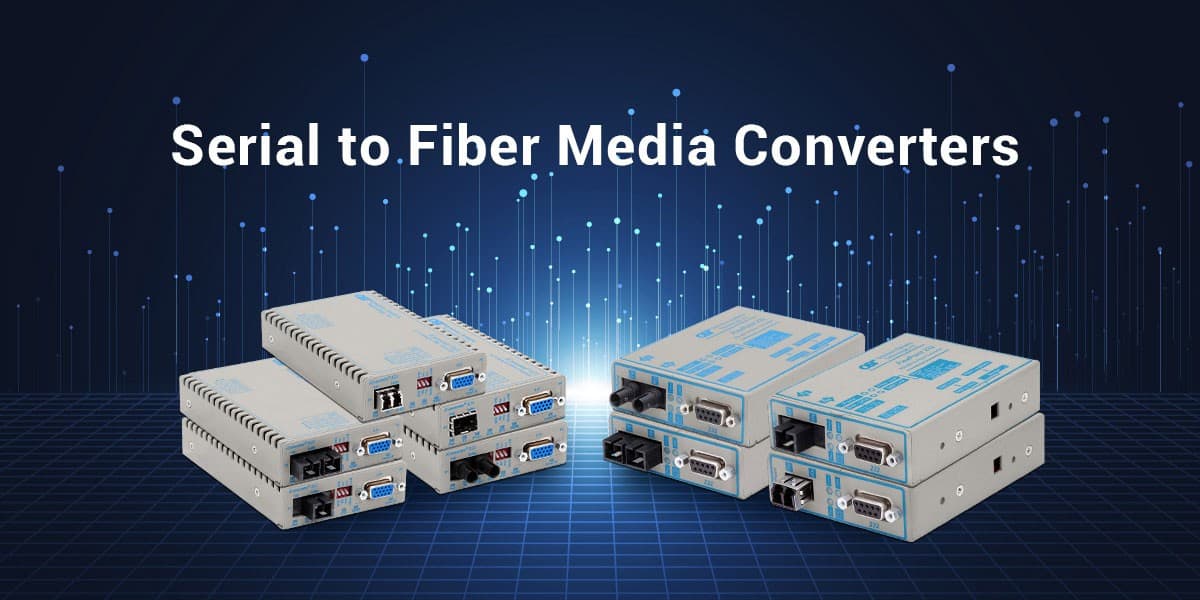
Serial-to-Fiber media converters are designed to convert electronic signals from serial protocol copper cables into optical signals via fiber optic cables. The maximum serial copper cable length is 4000 feet but depends on the recommended standard. And if the serial copper cable runs at a longer distance than its limitation, it affects data because of electromagnetic (EMI) and radio frequency (RFI) interference.
Serial devices like modems are used worldwide because they are easy to use and cost-effective. Serial communication bandwidth is roughly between 1200 and 115200 bits per second (bps). The fiber connection is the best solution to send data over a longer distance with noise immunity.
Serial Interfaces
In telecommunication, the serial interface is a communication interface. The serial interface transmits data between two digital systems as a series of voltage pulses over a wire-plus-ground cable or a single wireless channel.
Interfaces of Serial-to-Fiber Converters
There are three primary Serial Interfaces for Serial-to-Fiber Converters, including RS-232, RS-422, and RS-485. RS stands for Recommended Standard, the standard for serial communication data transmission. EIA labeled RS in April 1983 and the RS was replaced with "EIA/TIA" to identify the standard's origin. However, engineers and application guides continue to use the RS. Now, the TIA maintains the standard since the EIA was officially disbanded.
RS-232
RS-232 is a serial communication standard for data transmission introduced by the Electronic Industries Association (EIA). RS-232 is used for medium distances and defines signals that connect a DTE (data terminal equipment) and a DCE (data circuit-terminating equipment or data communication equipment).
RS-422
RS-422 or TIA/EIA-422 is a technical standard that specifies differential signaling, which is a method for electrically transmitting data using two complementary signals. The Electronic Industries Alliance originated the RS-422 or TIA/EIA-422 to replace the older standard, RS-232C, as they offer much higher speed, better noise immunity and longer cable lengths.
RS-485
RS-485, also known as TIA-485(-A) or EIA-485, assures differential data transmission. The Telecommunications Industry Association and Electronic Industries Alliance (TIA/EIA) publish the RS-485 standard. The standard supports multipoint systems and balances electrical signaling. The RS-485 standard is used to communicate high data rates over large distances and supports industrial control systems and similar applications.
RS-530
RS-530 is an electrical and mechanical standard that defines the characteristics of a synchronous serial interface used for data communication. It was established by the Electronic Industries Association (EIA) and is primarily used in the United States.
The RS-530 standard specifies the pin assignments, voltage levels, and signaling parameters required for connecting data terminal equipment (DTE) and data circuit-terminating equipment (DCE) through a synchronous serial interface.
RS-530 supports relatively high data rates compared to older serial standards, allowing for transmission speeds of up to 2 Mbps. Differential signaling is employed, meaning that two wires are used for each signal: one wire for the positive signal and another wire for the inverted (negative) signal. This approach enhances noise immunity and improves data transmission reliability.
X.21
X.21 is a protocol standard defined by the International Telecommunication Union (ITU-T) that specifies the physical and electrical characteristics of a synchronous serial interface for the transmission of data over digital networks.
It is frequently used to link data circuit-terminating equipment (DCE) like modems or multiplexers to data terminal equipment (DTE) like computers, routers, or other devices.
While X.21 was commonly used to connect devices across digital networks, more recent and faster protocols like Ethernet and its many variations have mostly replaced it. Nevertheless, X.21 continues to find some specialized uses in select industries or situations where the use of legacy hardware is required.
Serial Interfaces comparison
Each Recommended Standard was intended to replace the older standard to offer much higher speed, better noise immunity and longer cable lengths.
| Serial Interfaces | Cabling | Data rate | cable length | Speed | Topology |
|---|---|---|---|---|---|
|
RS-232 |
Single ended |
19.2 kbps |
50 feet |
Full-duplex |
Point-to-point |
|
RS-422 |
Differential |
10 Mbps |
4000 feet |
Full-duplex |
Point-to-point |
|
RS-485 |
Differential |
10 Mbps |
4000 feet |
Half-duplex |
Multi-drop |
|
X.21 |
Differential |
Up to 8.192 Mbps |
196 feet |
Full-duplex |
Point-to-point |
How does Serial-to-Fiber Media Converter work?
The serial-to-fiber media converter converts optical signals to electronic signals, allowing full-duplex transmission and a rugged, secure, and easily deployable optical link. And they support point-to-point and multipoint configurations. Serial to Fiber Media Converters extend serial network distances 40km over single-mode single-fiber and up to 120km over dual fiber.
Managed and Unmanaged Serial-to-Fiber Media Converter
Like other fiber media converters, serial-to-fiber media converters are available as managed or unmanaged. A managed serial-to-fiber media converter is more costly than an unmanaged one but reduces operating costs and improves network reliability by providing network monitoring, fault detection and remote configuration.
With the installation of NMM2 or NID in the same chassis as a managed serial to fiber media converter, the management will be achieved, providing access to all the advanced features available on the module.
The real-time parameters that can be monitored include:
- Data activity status
- Serial numbers
- Module type and model
- Hardware and software revisions
- User-defined identifier
- Power and link
On the contrary, unmanaged Serial Media Converters are easy to install since they require minimal configuration and provide cost-effective fiber extensions for serial connections. But they don't provide network monitoring, fault detection and remote configuration.
| Serial Media Converters |
Managed / Unmanaged Serial Media Converters |
Serial Interfaces | Product |
|---|---|---|---|
|
RS-232 to Fiber Media Converter |
Managed Serial Media Converters |
RS-232 |
iConverter RS232 serial RS-232 media converter transports serial protocol over fiber media |
|
RS-422 and RS-485 to Fiber Media Converter |
Unmanaged Serial Media Converters |
RS-422 / RS-485 |
iConverter RS422/485 media converters transport serial RS-422 and RS-485 protocols over fiber media |
|
X21 and RS530 to Fiber Media Converter |
Unmanaged Serial Media Converters |
RS530 |
iConverter X21 media converters transport serial X.21 and RS-530 protocols over fiber media |
|
RS-232 to Fiber Media Converter |
Unmanaged Serial Media Converters |
RS-232 |
FlexPoint 232 serial RS-232 to fiber converter transports serial protocol over fiber media |
Serial to Fiber Media Converters Applications
Here is a list of applications that Omnitron systems provide for the four products mentioned above. The RS-232, RS-422, or RS-485 serial equipment can be industrial or manufacturing equipment, casino games or utility SCADA equipment.
Serial RS-232 to Fiber Media Converter Application
In this application example, a serial RS-232 to fiber media converter is deployed in a star topology network. In the upper left, RS232 modules are installed in an iConverter 19-Module Chassis to provide high-density distribution of fiber links from a third-party terminal server with DB9 copper ports.
At each end of the fiber links, an RS232 module installed in an iConverter 1-Module Chassis provides the media conversion for connectivity to RS-232 equipment.
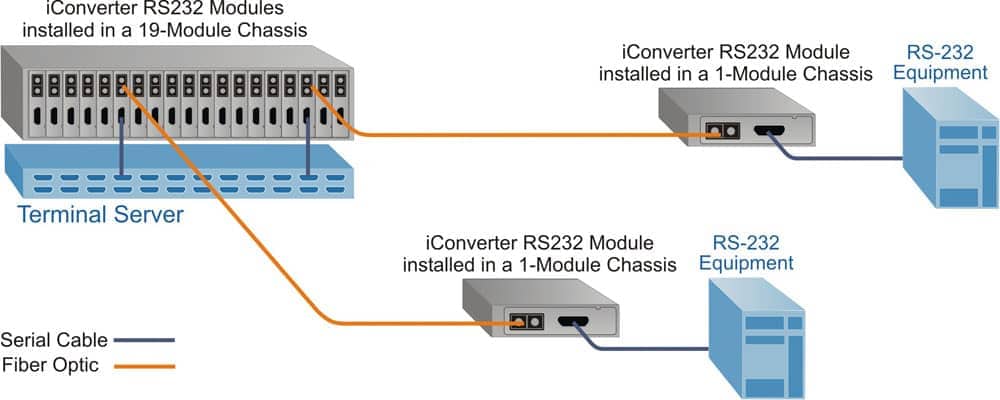
Managed Serial RS422/RS485 to Fiber Media Converter Application
In this application example, a managed serial RS-422 or RS-485 to fiber media converter is deployed in a bookend configuration to enable serial network distance extension over fiber. iConverter RS422/485 modules are installed at each end of the fiber link and provide media conversion for connectivity between a serial host and controller and multi-drop serial devices.

X.21 and RS-530 Serial to Fiber media converter Application
In this application example, a X21 serial-to-fiber converter provides a secure and safe environment to control high security or hazardous environments by extending the distance between locations up to 120km over single-mode fiber.
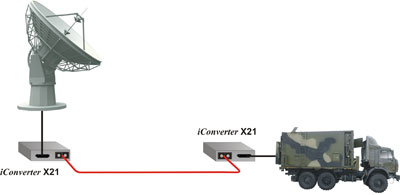
Unmanaged RS-232 to Fiber Media Converter
In this application example, a pair of unmanaged RS-232 to fiber media converters provide the serial connection between a PC and Terminal Server to allow access to multiple data devices via fiber. Multimode or single-mode fiber can be used, and single-mode fiber can be used to extend fiber links up to 60km.
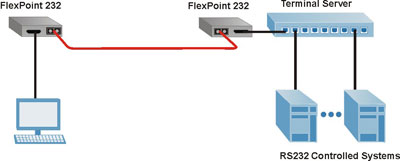
On a Final Note
Serial-to-Fiber media converters are designed to convert electronic signals from serial protocol copper cables into optical signals via fiber optic cables. They support point-to-point and multipoint configurations. They extend serial network distances up to 120km over dual fiber and 40km over single-mode single-fiber.
Omnitron Systems is a privately held company headquartered in Irvine, California and manufactures all its products in the United States. We provide a lifetime warranty on all of our managed and unmanaged media converters. If you have any future questions about media converters or want to get pre-sale support, give us a call; we are available 24/7 to answer your questions. Call us now to get pre-sale support.
At Omnitron, we understand that network design is essential to any successful IT infrastructure. That's why we offer free network design services to our customers. Our experienced network engineers will collaborate with you to develop a comprehensive design that meets your unique needs, budget and time limit. Schedule a Free Network Design session.
References:
https://en.wikipedia.org/wiki/RS-485
https://en.wikipedia.org/wiki/RS-422
https://en.wikipedia.org/wiki/RS-232#cite_note-Metering_Glossary-1
https://www3.nd.edu/~lemmon/courses/ee224/web-manual/web-manual/lab9/node4.html









